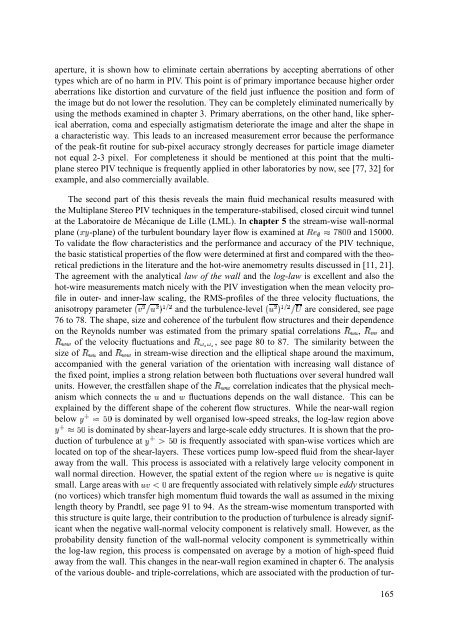The significance of coherent flow structures for the turbulent mixing ...
The significance of coherent flow structures for the turbulent mixing ...
The significance of coherent flow structures for the turbulent mixing ...
Create successful ePaper yourself
Turn your PDF publications into a flip-book with our unique Google optimized e-Paper software.
aperture, it is shown how to eliminate certain aberrations by accepting aberrations <strong>of</strong> o<strong>the</strong>r<br />
types which are <strong>of</strong> no harm in PIV. This point is <strong>of</strong> primary importance because higher order<br />
aberrations like distortion and curvature <strong>of</strong> <strong>the</strong> field just influence <strong>the</strong> position and <strong>for</strong>m <strong>of</strong><br />
<strong>the</strong> image but do not lower <strong>the</strong> resolution. <strong>The</strong>y can be completely eliminated numerically by<br />
using <strong>the</strong> methods examined in chapter 3. Primary aberrations, on <strong>the</strong> o<strong>the</strong>r hand, like spherical<br />
aberration, coma and especially astigmatism deteriorate <strong>the</strong> image and alter <strong>the</strong> shape in<br />
a characteristic way. This leads to an increased measurement error because <strong>the</strong> per<strong>for</strong>mance<br />
<strong>of</strong> <strong>the</strong> peak-fit routine <strong>for</strong> sub-pixel accuracy strongly decreases <strong>for</strong> particle image diameter<br />
not equal 2-3 pixel. For completeness it should be mentioned at this point that <strong>the</strong> multiplane<br />
stereo PIV technique is frequently applied in o<strong>the</strong>r laboratories by now, see [77, 32] <strong>for</strong><br />
example, and also commercially available.<br />
<strong>The</strong> second part <strong>of</strong> this <strong>the</strong>sis reveals <strong>the</strong> main fluid mechanical results measured with<br />
<strong>the</strong> Multiplane Stereo PIV techniques in <strong>the</strong> temperature-stabilised, closed circuit wind tunnel<br />
at <strong>the</strong> Laboratoire de Mécanique de Lille (LML). In chapter 5 <strong>the</strong> stream-wise wall-normal<br />
plane (ñŸ¹ -plane) <strong>of</strong> <strong>the</strong> <strong>turbulent</strong> boundary layer <strong>flow</strong> is examined at ª«§=@? í parameter and <strong>the</strong> ¸ ä í ½A=@? í ï B<br />
turbulence-level<br />
76 to 78. <strong>The</strong> shape, size and coherence <strong>of</strong> <strong>the</strong> <strong>turbulent</strong> <strong>flow</strong> <strong>structures</strong> and <strong>the</strong>ir dependence<br />
on <strong>the</strong> Reynolds number was estimated from <strong>the</strong> primary spatial ªS·· correlations ªSÔÔ , and<br />
<strong>of</strong> <strong>the</strong> velocity fluctuations and ªDC#EFC#E , see page 80 to 87. <strong>The</strong> similarity between <strong>the</strong><br />
ªSÙ&Ù<br />
size ªS·· <strong>of</strong> ªSÙ&Ù and in stream-wise direction and <strong>the</strong> elliptical shape around <strong>the</strong> maximum,<br />
accompanied with <strong>the</strong> general variation <strong>of</strong> <strong>the</strong> orientation with increasing wall distance <strong>of</strong><br />
<strong>the</strong> fixed point, implies a strong relation between both fluctuations over several hundred wall<br />
units. However, <strong>the</strong> crestfallen shape <strong>of</strong> ªSÙ&Ù <strong>the</strong> correlation indicates that <strong>the</strong> physical mechanism<br />
which connects ä <strong>the</strong> å and fluctuations depends on <strong>the</strong> wall distance. This can be<br />
explained by <strong>the</strong> different shape <strong>of</strong> <strong>the</strong> <strong>coherent</strong> <strong>flow</strong> <strong>structures</strong>. While <strong>the</strong> near-wall region<br />
¹¥»&% °<br />
below is dominated by well organised low-speed streaks, <strong>the</strong> log-law region above<br />
is dominated by shear-layers and large-scale eddy <strong>structures</strong>. It is shown that <strong>the</strong> pro-<br />
°<br />
¹&»G%<br />
duction <strong>of</strong> turbulence ¹ »<br />
¡ °<br />
at is frequently associated with span-wise vortices which are<br />
located on top <strong>of</strong> <strong>the</strong> shear-layers. <strong>The</strong>se vortices pump low-speed fluid from <strong>the</strong> shear-layer<br />
away from <strong>the</strong> wall. This process is associated with a relatively large velocity component in<br />
wall normal direction. However, <strong>the</strong> spatial extent <strong>of</strong> <strong>the</strong> region äŸã where is negative is quite<br />
small. Large areas äŸã Û with are frequently associated with relatively simple eddy <strong>structures</strong><br />
(no vortices) which transfer high momentum fluid towards <strong>the</strong> wall as assumed in <strong>the</strong> <strong>mixing</strong><br />
length <strong>the</strong>ory by Prandtl, see page 91 to 94. As <strong>the</strong> stream-wise momentum transported with<br />
this structure is quite large, <strong>the</strong>ir contribution to <strong>the</strong> production <strong>of</strong> turbulence is already significant<br />
when <strong>the</strong> negative wall-normal velocity component is relatively small. However, as <strong>the</strong><br />
probability density function <strong>of</strong> <strong>the</strong> wall-normal velocity component is symmetrically within<br />
<strong>the</strong> log-law region, this process is compensated on average by a motion <strong>of</strong> high-speed fluid<br />
away from <strong>the</strong> wall. This changes in <strong>the</strong> near-wall region examined in chapter 6. <strong>The</strong> analysis<br />
<strong>of</strong> <strong>the</strong> various double- and triple-correlations, which are associated with <strong>the</strong> production <strong>of</strong> tur-<br />
165
















